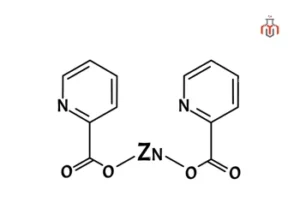
Zinc picolinate (ZnPic) is a salt of picolinic acid, consisting of two bidentate picolinate ligands and two aquo (water) ligands. It is primarily used as a nutritional supplement for zinc deficiency. It significantly increases zinc levels in the body and plays a role in numerous enzymatic reactions, immune function, protein synthesis, wound healing, DNA synthesis, and cell division.
Zinc picolinate also appears to be the most effective form for reversing zinc deficiency in conditions such as Acrodermatitis enteropathica and is more effectively absorbed compared to other forms of zinc supplements.

CAS No.: 17949-65-4
Synonyms: Zinc di (2-pyridinecarboxylate), Zinc(II) picolinate, Zinc bis(pyridine-2-carboxylate)
| Physical Properties | |
| Chemical formula | C12H8N2O4Zn |
| IUPAC name | zinc;pyridine-2-carboxylate |
| Molecular weight | 309.59 g/mol |
| Solubility | Slightly soluble in water |
| Odor | Odorless |
| Flash point | 130.7 °C |
| Chemical Properties | |
| Color | White |
| State | Crystalline or fine powder |
| Melting point | 292.5 °C |
| Vapour pressure | 0.000836 mm/Hg at 25 °C |
| pH | 2 -2.5 |
| Storage | Store at Room temperature |
Zinc picolinate is safe; however, there may be some possible side effects in some individuals, such as –
| Pictograms : |
|
| Hazard Statements : | H302 Harmful if swallowed |
| Precautionary statements : | P270 Do not eat, drink, or smoke when using this product |
Zinc picolinate (ZnPic) is a salt of picolinic acid, consisting of two bidentate picolinate ligands and two aquo (water) ligands. It is primarily used as a nutritional supplement for zinc deficiency. It significantly increases zinc levels in the body and plays a role in numerous enzymatic reactions, immune function, protein synthesis, wound healing, DNA synthesis, and cell division.
Zinc picolinate also appears to be the most effective form for reversing zinc deficiency in conditions such as Acrodermatitis enteropathica and is more effectively absorbed compared to other forms of zinc supplements.

CAS No.: 17949-65-4
Synonyms: Zinc di (2-pyridinecarboxylate), Zinc(II) picolinate, Zinc bis(pyridine-2-carboxylate)
| Physical Properties | |
| Chemical formula | C12H8N2O4Zn |
| IUPAC name | zinc;pyridine-2-carboxylate |
| Molecular weight | 309.59 g/mol |
| Solubility | Slightly soluble in water |
| Odor | Odorless |
| Flash point | 130.7 °C |
| Chemical Properties | |
| Color | White |
| State | Crystalline or fine powder |
| Melting point | 292.5 °C |
| Vapour pressure | 0.000836 mm/Hg at 25 °C |
| pH | 2 -2.5 |
| Storage | Store at Room temperature |
Zinc picolinate is safe; however, there may be some possible side effects in some individuals, such as –
| Pictograms : |
|
| Hazard Statements : | H302 Harmful if swallowed |
| Precautionary statements : | P270 Do not eat, drink, or smoke when using this product |
Zinc picolinate supports immunity, promotes hair and nail growth, maintains healthy skin and eyes, boosts testosterone production, and helps regulate blood sugar levels.
Zinc picolinate is the chelated form of zinc, which is absorbed more efficiently than other forms of zinc, while regular zinc is the common inorganic form, which is less absorbed and may cause more gastrointestinal discomfort.
Zinc picolinate can be taken daily, but excessive doses may interfere with the absorption of other minerals such as copper, which leads to bone abnormalities, anemia, impaired immune function, and neutropenia.
Zinc picolinate and magnesium glycinate can be taken together. Zinc supports immune function, enzyme activity, and cellular repair, while magnesium contributes to muscle relaxation, nerve function, sleep regulation, and energy production.
Zinc picolinate supports neurotransmitter activity, synaptic signaling, memory formation, and mood balance. However, it should be taken within recommended limits, as excessive zinc can have adverse neurological effects.
Zinc picolinate has anti-inflammatory properties and helps in regulating the body’s immune and inflammatory responses.